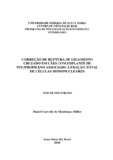| dc.creator | Müller, Daniel Curvello de Mendonça | |
| dc.date.accessioned | 2017-06-01 | |
| dc.date.available | 2017-06-01 | |
| dc.date.issued | 2010-04-09 | |
| dc.identifier.citation | MÜLLER, Daniel Curvello de Mendonça. Correction of ligament rupture in dogs with polypropylene implants linked to total fraction of mononuclear cells. 2010. 120 f. Tese (Doutorado em Medicina Veterinária) - Universidade Federal de Santa Maria, Santa Maria, 2010. | por |
| dc.identifier.uri | http://repositorio.ufsm.br/handle/1/4071 | |
| dc.description.abstract | The ligament rupture (LC) is lesion diagnosed in most dogs with joint problems, and the
most common cause is degenerative joint disease of the knee joint. This study aimed to
evaluate the action of the total fraction of mononuclear cells from autologous bone
marrow (FCMO) applied intra-articular by after surgical repair of ruptured cruciate
ligament. It is proposed a new technique for surgical correction of this disease, evaluating
clinically the action of a polypropylene mesh as the only substitute for cranial cruciate
ligament and flow of dogs. Twenty dogs underwent unilateral desmotomy cranial and
caudal LC. Twenty-one days after the break, all were treated surgically by the technique
of open reduction, with implantation of polypropylene replacing only the cranial cruciate
ligament (CCL). Ten animals received FCMO at the time of correction. The assessments
were by X-ray study, clinical examinations and biopsies at 50 and 90 days
postoperatively. The surgical technique has shown rapid implementation and low soft
tissue dissection, early return to ambulation and adequate strength of the implant. The
group that received FCMO grew intra-articular bone at the X-ray study, however, the
twenty animals showed CD34 positive in their biopsy samples, indicating a presence of
stem cells in both groups. It was concluded that there was no clinical difference between
the two groups until 90 days of evaluation. | eng |
| dc.description.sponsorship | Coordenação de Aperfeiçoamento de Pessoal de Nível Superior | |
| dc.format | application/pdf | por |
| dc.language | por | por |
| dc.publisher | Universidade Federal de Santa Maria | por |
| dc.rights | Acesso Aberto | por |
| dc.subject | Desmotomia do ligamento cruzado | por |
| dc.subject | Implante sintético | por |
| dc.subject | Células-tronco | por |
| dc.subject | Desmotomia cruciate ligament | eng |
| dc.subject | Synthetic implants | eng |
| dc.subject | Stem cells | eng |
| dc.title | Correção de ruptura de ligamento cruzado em cães com implante de polipropileno associado a fração total de células mononucleares | por |
| dc.title.alternative | Correction of ligament rupture in dogs with polypropylene implants linked to total fraction of mononuclear cells | eng |
| dc.type | Tese | por |
| dc.description.resumo | A ruptura do ligamento cruzado (LC) é uma lesão diagnosticada em grande parte dos cães
com problemas articulares, sendo a causa mais comum de afecção articular degenerativa
da articulação do joelho. Este trabalho teve por objetivo, avaliar a ação da fração total de
células mononucleares autógenas da medula óssea (FCMO) de aplicação intra-articular,
após a correção cirúrgica dos ligamentos cruzados rompidos. Foi proposta uma nova
técnica de correção cirúrgica desta afecção, avaliando-se clinicamente a ação da malha de
polipropileno como único substituto do ligamento cruzado cranial e caudal de cães.
Foram utilizados 20 cães, submetidos à desmotomia unilateral dos LC cranial e caudal.
Vinte e um dias após a ruptura, todos foram tratados cirurgicamente pela técnica de
redução aberta, com o implante de polipropileno, substituindo apenas o ligamento
cruzado cranial (LCC). Dez animais receberam a FCMO no momento da correção. As
avaliações se deram por estudo radiográfico, exames clínicos e biópsias aos 50 e 90 dias
pós-operatórios. A técnica cirúrgica proposta demonstrou ser de rápida execução e pouca
dissecação de tecidos moles, retorno precoce à deambulação e resistência adequada do
implante. O grupo que recebeu a FCMO apresentou crescimento ósseo intra-articular ao
estudo radiológico, contudo, os vinte animais apresentaram células CD34 positivas em
suas amostras biopsiadas, indicando haver presença de células-tronco em ambos os
grupos. Concluiu-se que não houve diferença clínica entre os dois grupos até os 90 dias
de avaliação. | por |
| dc.contributor.advisor1 | Pippi, Ney Luis | |
| dc.contributor.advisor1Lattes | http://buscatextual.cnpq.br/buscatextual/visualizacv.do?id=K4783382P7 | por |
| dc.contributor.referee1 | Schossler, Joao Eduardo Wallau | |
| dc.contributor.referee1Lattes | http://buscatextual.cnpq.br/buscatextual/visualizacv.do?id=K4784154D8 | por |
| dc.contributor.referee2 | Graça, Dominguita Luhers | |
| dc.contributor.referee2Lattes | http://buscatextual.cnpq.br/buscatextual/visualizacv.do?id=K4783904A3 | por |
| dc.contributor.referee3 | Aguiar, Eduardo Santiago Ventura de | |
| dc.contributor.referee3Lattes | http://buscatextual.cnpq.br/buscatextual/visualizacv.do?id=K4761469D6 | por |
| dc.contributor.referee4 | Alievi, Marcelo Meller | |
| dc.contributor.referee4Lattes | http://buscatextual.cnpq.br/buscatextual/visualizacv.do?id=K4767491D6 | por |
| dc.creator.Lattes | http://buscatextual.cnpq.br/buscatextual/visualizacv.do?id=K4130963H9 | por |
| dc.publisher.country | BR | por |
| dc.publisher.department | Medicina Veterinária | por |
| dc.publisher.initials | UFSM | por |
| dc.publisher.program | Programa de Pós-Graduação em Medicina Veterinária | por |
| dc.subject.cnpq | CNPQ::CIENCIAS AGRARIAS::MEDICINA VETERINARIA | por |


